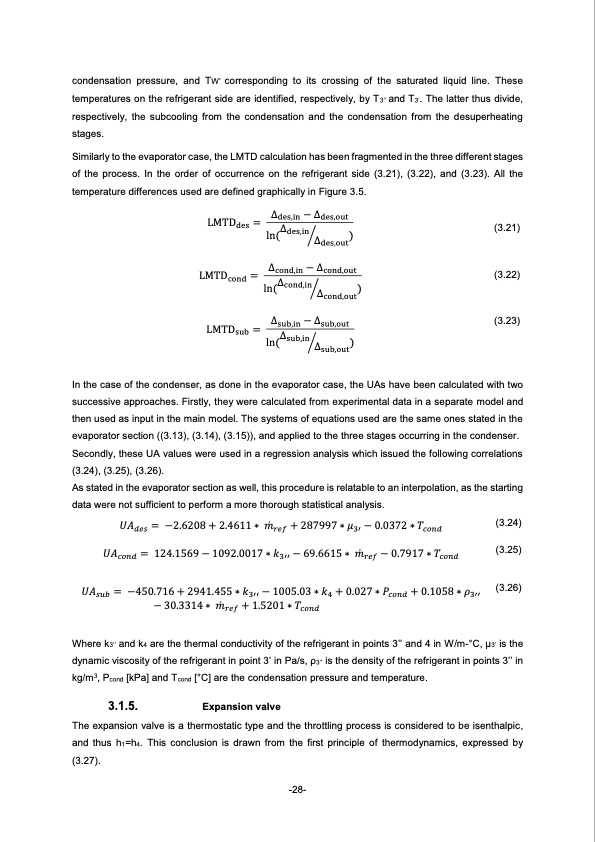
PDF Publication Title:
Text from PDF Page: 037
condensation pressure, and TW’ corresponding to its crossing of the saturated liquid line. These temperatures on the refrigerant side are identified, respectively, by T3’’ and T3’. The latter thus divide, respectively, the subcooling from the condensation and the condensation from the desuperheating stages. Similarly to the evaporator case, the LMTD calculation has been fragmented in the three different stages of the process. In the order of occurrence on the refrigerant side (3.21), (3.22), and (3.23). All the temperature differences used are defined graphically in Figure 3.5. LMTDdes = Δdes,in − Δdes,out Δdes,in ln( ⁄ ) Δdes,out (3.21) LMTDcond = LMTDsub = Δcond,in − Δcond,out Δcond,in ln( ⁄ ) Δcond,out Δsub,in − Δsub,out Δsub,in ln( ⁄ ) Δsub,out (3.22) (3.23) In the case of the condenser, as done in the evaporator case, the UAs have been calculated with two successive approaches. Firstly, they were calculated from experimental data in a separate model and then used as input in the main model. The systems of equations used are the same ones stated in the evaporator section ((3.13), (3.14), (3.15)), and applied to the three stages occurring in the condenser. Secondly, these UA values were used in a regression analysis which issued the following correlations (3.24), (3.25), (3.26). As stated in the evaporator section as well, this procedure is relatable to an interpolation, as the starting data were not sufficient to perform a more thorough statistical analysis. 𝑈𝐴 = −2.6208+2.4611∗ 𝑚̇ 𝑑𝑒𝑠 𝑟𝑒𝑓 +287997∗𝜇 −0.0372∗𝑇 𝑈𝐴 = 124.1569 − 1092.0017 ∗ 𝑘 𝑐𝑜𝑛𝑑 3′′ − 69.6615 ∗ 𝑚̇ 𝑟𝑒𝑓 𝑈𝐴 = −450.716+2941.455∗𝑘 −1005.03∗𝑘 +0.027∗𝑃 +0.1058∗𝜌 𝑠𝑢𝑏 3′′ 4 𝑐𝑜𝑛𝑑 3′′ − 30.3314 ∗ 𝑚̇ + 1.5201 ∗ 𝑇 𝑟𝑒𝑓 𝑐𝑜𝑛𝑑 3′ 𝑐𝑜𝑛𝑑 − 0.7917 ∗ 𝑇 𝑐𝑜𝑛𝑑 (3.24) (3.25) (3.26) Where k3’’ and k4 are the thermal conductivity of the refrigerant in points 3’’ and 4 in W/m-°C, μ3’ is the dynamic viscosity of the refrigerant in point 3’ in Pa/s, ρ3’’ is the density of the refrigerant in points 3’’ in kg/m3, Pcond [kPa] and Tcond [°C] are the condensation pressure and temperature. 3.1.5. Expansion valve The expansion valve is a thermostatic type and the throttling process is considered to be isenthalpic, and thus h1=h4. This conclusion is drawn from the first principle of thermodynamics, expressed by (3.27). -28-PDF Image | Next generation of refrigerants for residential heat pump systems

PDF Search Title:
Next generation of refrigerants for residential heat pump systemsOriginal File Name Searched:
MartinaLonghini_ThesisReport.pdfDIY PDF Search: Google It | Yahoo | Bing
CO2 Organic Rankine Cycle Experimenter Platform The supercritical CO2 phase change system is both a heat pump and organic rankine cycle which can be used for those purposes and as a supercritical extractor for advanced subcritical and supercritical extraction technology. Uses include producing nanoparticles, precious metal CO2 extraction, lithium battery recycling, and other applications... More Info
Heat Pumps CO2 ORC Heat Pump System Platform More Info
| CONTACT TEL: 608-238-6001 Email: greg@infinityturbine.com | RSS | AMP |